That’s Typical
I’ve measured the average skin track angle in the Tahoe area. A few folks are waking up, but the majority of skin tracks are still in the 20° range, usually 22°–23°. Most guides I know insist they are setting a low angle track but consistently exceed the AMGA recommended guideline of 15°–18°. Tahoe chargers prefer 25° — it’s the same in the Wasangles, Cascades, Tetons and Rockies. It’s a great sprint for revving you heart rate, and it leaves a sadistic line that challenges all neanderfollowers.
It is one thing to be able to make and hold a steep line, it is another to masochistically subject yourself to it as if you need to continually prove you’re man enough. The way I look at it, if you’re going to expend that much energy, why not just break trail and pave something that will allow you to halve your energy output on the next lap? Besides, who needs more pavement in life? I’m out for fresh tracks, and that includes the uphill. Which is an argument for setting your own track. You get freshies on the way up too, and you will inevitably follow the path that matches your personal rhythm, the major benefit to seeking the low road.But enough of why you want to make a low angle skin track. There’s is a host of practical issues you need to deal with that pertain to how you make a low angle skin track.
Mind Games
The first issue to consider is mental, but there are also some movement patterns you can adopt that help you stay on the low-angle track. Mentally the biggest obstacle to overcome is the belief that steeper is better. Unless you can mentally seek the low road, you will not find it — it remains invisible to you.Every slope I’ve ever been on has ridges and gullies in between. Sometimes when you’re traversing all you can see is to the edge of the ridge that prevents a view around the corner to the inevitable gully behind it. With experience I’ve found an opening in the low angle line will usually appear as you round the bend.
Whenever you look to the next micro passage in the terrain there is a high point and a low point that you can aim for, both which yield elevation. The natural tendency is to aim for the high point to get more elevation. To hold the low angle line, you must consciously chose the lower option first. Always.
Of course there are exceptions to this rule, but the key to staying low is aiming there. It is a constant mental battle.
Steady rate of Incline
In setting a low angle skin track, one of the other guiding principles is to maintain a steady rate of incline, ideally with zero deviations. Therefore, loosing ground is worse than acquiescing to a slight, temporary increase in the angle.What this requires is changing direction a lot to account for contouring around micro ridges and gullies that seem to just add distance to the climb. However, unless you veer around these features, you end up making lots of adjustments to the pitch of your path which interrupts a steady pace, you lose the rhythm in your stride as you as alternately strain for a few steep steps, then glide the backside, and finally return to a steady uphill stride, but only as long as the terrain remains smooth. A good low angle track delivers a steady, rhythmic motion that allows you to maintain your pace for an hour or more without taking a break, irrespective of the terrain.
Breaking the Steep Technique Habit
The best way to learn how to set a low angle skin track is to use waxless skis. The pattern in the base of skis will grip, but not very steeply, thus forcing a low angle track – 10° is typical in grippy snow. Using such skis to climb 1000 vertical feet or so will require you to adopt your technique. Whereas you can dig in and drive straight up and over minor undulations in the slope with skins, with a waxless pattern you must bear off to maintain forward and upward momentum.This ability to milk the terrain with micro-contours is the hallmark of a low-angle skin track. Lots of people think they are setting a low-angle track, and generally go fairly low angle, except for how they navigate minor rolls in the slope. A true low-angle track climbs across a gully, and bears off when it hits a ridge. The average competitive skin track will rise with the ridge, and drop through the dips, regularly changing the angle of ascent. Meanderthals hold steady on the angle of ascent, micro managing the direction of ascent instead, bearing off as the slope steepens or rounding up as it recedes.
Meandering Blind
One of the best tricks I’ve learned for achieving this is to feel the resistance at the shovel of your ski as it brushes against the snow while breaking trail. My friend Robert passed it on and he learned it from Reudi Beglinger, a master of setting a skin track you can follow for hour upon hour, lap upon lap, even though Ruedi never does laps from the same peak.Take some time to sense the tip resistance, and then on a simple, wide open slope with no contours just feel that level of resistance while breaking a low angle skin track of only 10°. Do it just to calibrate what 10° feels like and then ramp up to whatever angle feels most comfortable in the 15° zone, plus or minus a few. Let the terrain help you decide that, but then let the gliding resistance of your ski tip help you aim what angle your ski cuts through the snow at. This can help you to hold that angle of attack, even in a white out.
Train Tracks
My other fave mental game is to imagine that I’m setting track for a train. Trains simply cannot climb very steeply and they wind this way and that, switchbacking in valleys and following every contour as they zig-zag across a slope until they duck through to the otherside in a tunnel. The major difference between a set of steel rails and the track I set is, unlike the iron horse, I can and regularly do set a wicked sharp switchback; much easier than tunneling. 😉
Spice it up
Variety is the spice of life and skin tracks are no different. Even the AMGA has codified the importance of a low angle skin track by officially recommending all guides set a 15°–18° skin track. That’s a good range and whether you’re on the low or high side of that depends on a lot of personal factors. If you’re on AT gear, you’re more likely to favor the high side. Most AT boots don’t offer the forward flexibility that tele boots do, which makes a flat climbing post less comfortable unless you’re setting a 10° track which is too low. Any way you cut it though, each of us has a different physical rhythm and preferred skin track angle. Find where you prefer and add some of these meanderthal techniques to your bag of skin tricks. I promise, it won’t hurt you one iota.© 2014

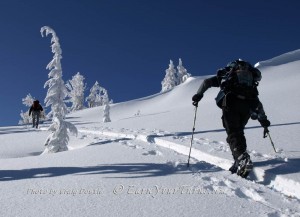
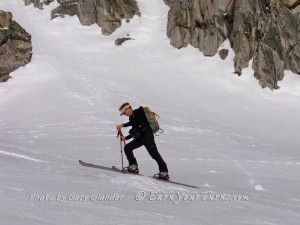
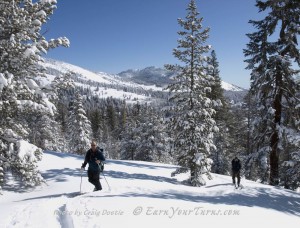
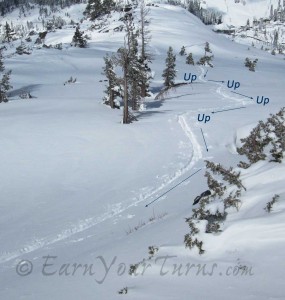
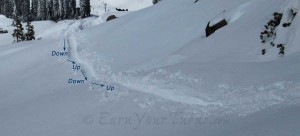
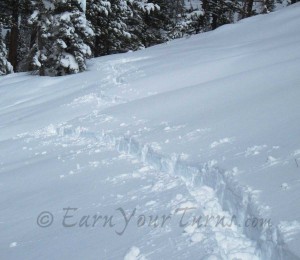
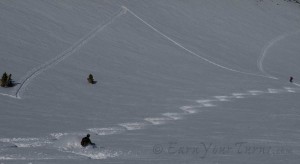
1 comment
Real men herringbone with their waxless skis.